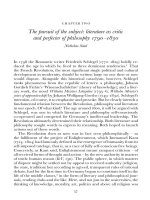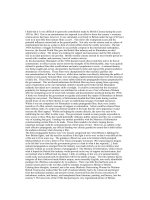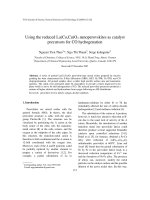Using the reduced La(Co,Cu)03nanoperovskites as catalyst precursors for CO hydrogenation
Bạn đang xem bản rút gọn của tài liệu. Xem và tải ngay bản đầy đủ của tài liệu tại đây (1.45 MB, 11 trang )
<span class='text_page_counter'>(1)</span><div class='page_container' data-page=1>
V N U J o u rn a l o f S cien ce, N a tu r a l S cic n c c s a n d T ech n o lo g y 25 (2009) 112-122
<b>Using the reduced La(Co,Cu</b>
)03
<b> nanoperovskites as catalyst </b>
<b>precursors for CO hydrogenation</b>
<b>Nguyen Tien Thao'’*, Ngo Thi Thuan^, Serge kaliaguine^</b>
<i>^ Faculty o f Chemistry, College o f Science, VNU, 19 Le Thanh Tong, Hanoi, Vietnam </i>
<i>^Department o f Chemical Engineering, Laval University, Quebec, Canada. G IK 7P4</i>
Received 07 December 2007
A bstract. A series o f ground La(Co,Cu)03 perovskite-type mixed oxides prepared by reactive
grinding has been characterized by X-Ray diffraction (XRD), BET, H2-TPR, O2-TPD, and CO
disproportionation. All ground sanples show a rather high specific surface area and nanomeữic
particles. The solids were prefreated under H2 aừnosphere to provide a finely dispersed Co-Cu
phase which is active for the hydrogenation of CO. The reduced perovskite precursors produced a
mixtiưe o f higher alcohols and hydrocarbons from syngas following an ASF distribution.
<i>Keywords: perovskite; Co-Cu metals; syngas; alcohol synthesis.</i>
<b>1. Introduction</b>
Perovskites are m ixed oxides w ith the
general form ula AtíUs- In theoiy, the ideal
perovskite structure is cubic w ith the space-
group Pm 3m -O h [1]. T he structure can be
visualized by positioning the A cation at the
body center o f the cubic cell, the transition-
m etal cation (B) at the cube com ers, and the
oxygen at the m idpoint o f the cube edges. In
this structure, the transition-m etal cation is
therefore 6-fold coordinated and the A -cation is
12-fold coordinated w ith the oxygen ions.
M oreover, each o f the A and B positions could
be partially replaced by an o th er elem ent to
prepare a variety o f derivatives [1,2]. For
exam ple, a partial substitution o f La in
<b>’ Corresponding author. Tel.; 84-4-39331605. </b>
<b>E-mail: </b>
lanthanum -cobaltate by either Sr or Th has
rem arkably affected the rate o f carbon dioxide
hydrogenation [3] and m ethane oxidation [4].
The substitution o f the cation at A-position,
how ever, is m uch less atừactive than that at B-
site due to the usual lack o f activity o f the A
cation. M eanw hile, the introduction o f another
transition m etal into perovskite lattice could
therefore produce several supported bimetallic
catalysts upon controlled reductions [5-8].
Bedel et al. [5], for instance, obtained a Fe-Co
alloy after reduction o f LaFeo 75C00.25O3
orthorhom bic perovskite at
<b>600°c. </b>
Lima and<b>A ssaf [8] found that the partial substitution o f </b>
Ni by Fe in the perovskite lattice leads to a
decreased reduction tem perature o f ions
</div>
<span class='text_page_counter'>(2)</span><div class='page_container' data-page=2>
<i>N .T . T h a o et al. / V N U j o u r n a l o f Scien c e, N a tu r a l S c ie n c e s a n d T e c h n o lo g y 2 5 ( 2 0 0 9 ) 1 1 2 -1 2 2</i> <b>113</b>
the reduction-oxidation cycles o f perovskites
under tailored conditions could produce active
transition metals dispersed on an oxide (Ln
2Ơ
3)
matrix [5,7,8]. This characteristic may be used
for a promising pathway o f development o f a
finely dispersed metal catalyst from perovskite
precursors.
bi several previous contributions [7,9-11],
we have reported some novel characteristics of
lanthanum-cobaltates prepared by reactive
grinding. This article is to further prepare well-
homogenized supported Co-Cu metals for the
conversion of syngas to higher alcohols and
hydrocarbons.
<b>2. Experimental</b>
<i>2.1. M aterials</i>
LaCoi-xCuxOs perovskite-type mixed oxides
were synthesized by the reactive grinding
method also designated as mechano-synthesis
m literature [9-11], In brief, the stoichiometric
proportions of commercial lanthanum, copper,
and cobalt o x id e s (9 9 % , A ld r ic h ) w e re m ixed
together with three hardened steel balls
(diameter =
11mm) in a hardened steel crucible
(50 ml). A SPEX high energy ball mill working
at
1 0 0 0rpm was used for mechano-synthesis
for
8hours. Then, the resulting powder was
mixed to 50% sodium chloride (99.9%) and
further milled for
1 2hours before washing the
additives with distilled water. The slurry was
dried in oven at 60-80°C before calcination at
250'’C fo rl5 0 m in .
A reference sample, LaCoOs + 5.0 w
1%
Cu^O, was prepared by grinding a mixture of
the ground perovskite LaCo
0 3having a specific
surface area of 43 mVg with CU
2O oxide (10:1
molar ratio) at ambient temperature without any
grinding additive before drying at 120°c
overnight in oven.
<i>2.2. Characterization</i>
The chemical analysis (Co, Cu, Fe) o f the
perovskites and the residual impurities was
perfonned by AAS using a Perkin-Elmer
llOOB spectrometer. The specific surface area
( Sb e t)
of all obtained samples was determined
from nitrogen adsorption equilibrium isotherms
at -196°c measured using an automated gas
sorption system (NOVA 2000; Quantachrome).
Phase analysis and particle size determination
were performed by powder X-ray diffraction
(XRD)
using
a
SIEMENS
D5000
diffractometer with CuKa radiation (X =
1.54059 nm).
T em p e ra tu re p ro g ra m m e d ch aracterizatio n
(TPR, TPD, CO dissociation) was examined
using a multifunctional catalyst testing (RXM-
100 from Advanced Scientific Designs, Inc.).
P rio r to e a c h test a n a ly s is , a 5 0 m g sam p le w a s
calcined at 500°c for 90 min under flowing
20% O2/IIC (20 111I/11Ú11, la m p 5"c / u iin ). T h e
sam p le w a s then c o o le d d o w n to room
tem perature u n d er flo w in g p u re H e (2 0
m L/m in ). T P R o f the c a ta ly s t w a s then carried
out b y ra m p in g u n d er 4 .6 5 v o l% o f H2/ A J (2 0
m l/m in)
from room temperature up to 800“c
(5“c/min). The effluent gas was passed through
a cold trap (dry ice/ethanol) in order to remove
water prior to detection. For TPD analysis, the
O2-T P D c o n d itio n s w e re 2 0 m l/m in H e,
temperature from 25 to 900°c (5°c/min). The
m/z s ig n a ls o f 1 8 , 2 8 , 3 2 , 4 4 w e re c o lle c te d
</div>
<span class='text_page_counter'>(3)</span><div class='page_container' data-page=3>
114 <i>N.T. Thao et al. / V N U journal o f Science, Natural Sciences and Technology 25 (2009) ĨÌ2 -Ĩ2 2</i>
capillary colum n (W cot fused silica, 60m X
0.53mm, C oating Cp-Sil 5CB, DF = 5.00 ^m )
connected to a FED (V arian CP - 3800) and
mass spectrom eter (V arian Saturn 2200
G C/M S/M S). The selectivity to a given product
is defined as its w eight percent w ith respect to
all products excluding C O2 and water.
Productivity is defined here as a weight (mg)
product per gram o f catalyst p er hour.
100). The m/z signals o f 18, 28, 32, and 44
were collected.
<i>2.3. Catalytic perform ance</i>
The catalytic tests were carried out in a
stainless-steel continuous flow fixed-bed micro-
reactor (BTRS - J r PC, A utoclave Engineers).
<i>Catalysts were preữeated in situ under flowing</i>
5 vol% o f H j/A r (20 m l/m in) at
250°c
(3h) and500”C (3h) with a ram p o f 2°c/m in. Then, the
reactor was cooled dow n to the reaction
temperature while pressure was increased to
1000 psi by feeding the reaction m ixture. The
products were analyzed using a gas
chromatograph equipped w ith two capillary
columns and an autom ated online gas sam pling
valve maintained at
170”c . CO
andCO
2 wereseparated using a capillary colum n (Carboxen™
1006 PLOT, 30m X 0.53m m ) connected to the
TCD. Quantitative analysis o f all organic
products was carried out using the second
<b>Table 1. Physical properties o f ground La(Cu,Cu)Oj perovskites</b>
<b>3. Results and discussion</b>
<i>3.1. Physico-chem ical properties</i>
Table 1 collects the chem ical composition
and some physical properties o f all the ground
perovskites. The specific surface area is rather
higher (16-60m^/g) because o f the low synthesis
temperature (~ 40°C), w hich allow s to avoid the
agglomeration o f perovskite particles [7.11],
<b>Samples</b> <b><sub>S</sub>bet</b>
<b>(la ’/g)</b>
<b>Crystal</b>
<b>(iua)’</b>
<b>domain </b> <b>Com position (wt.% )</b>
<b>Na"</b> <b>Co</b> <b>Cu</b> <b>rc^</b>
<b>LaCoOa</b>
LaCoo.9Cuo.1O3
<b>59.6</b> <b>9.8</b> <b>0.53</b> <b>21.15</b> <b>-</b> <b>4.69</b>
<b>19.5</b> <b>9,7</b> <b>0.31</b> <b>19.31</b> <b>1.89</b> 1 . 1 2
<b>LaCoo </b>7<b>CU</b>03<b>O</b>3 <b>22.3</b> <b>9.9</b> <b>0.17</b> <b>16.77</b> <b>5.79</b> 1 . 2 1
<b>LaCoo </b>5C110 5O3 10 .6 <b>9.2</b> <b>0.44</b> <b>10.60</b> <b>9.96</b> <b>0.6 4</b>
<b>CujO/LaCoOj </b> <b>16.8 </b> <b>10.9 </b> <b>0.39</b>
<b>___ _______________ V. _ _ </b> <b>, L </b> <b>_ f., _</b> <b>20.04</b> <b>3.28</b> <b>4.78</b>
As mentioned in experim ental Section, the
addition o f a grinding additive (NaCl) during
the last milling step leads to the partial
separation o f the crystal dom ains, m aking a
significant change in surface-to-volum e ratio
and in the internal porosity o f elem entary
nanometric particles [10,11], Consequently, the
surface area o f such perovskites significantly
increases [10], It seem s that the presence o f
copper in the perovskite lattice leads to a
decreased surface area o f LaCo0 3. Indeed, the
surface area ( Sbet) o f all C u-based perovskites
(x < 0.3) and the m ixed oxides (C u2 0/LaCoƠ3)
is much low er than that o f the copper-free
sample (LaC oO j) [6,7,11,12], The X-ray
diffraction patterns are sfiown in Fig. 1. Their
diffractogram s indicate that all La-Co-Cu
</div>
<span class='text_page_counter'>(4)</span><div class='page_container' data-page=4>
<i>N .T . T hao e t al. / V N U jo u r n a l o f S cien c e, N a tu r a l S c ie n c e s a n d T e c h n o lo g y 2 5 (2 0 0 9 ) Ĩ 1 2 - 1 2 2</i> <b>115</b>
equation from X-ray line broadening are in the
range of 9-10 nm (Table 1), in good agreement
with the results reported previously [9,12,13].
Although all ground samples always contain a
small amount of iron oxide impurities, no FeOx
species are detected by XRD (Table 1 and Fig.
1). For sample CuoO/LaCoOj, it is clearly
observed that two strong reflection lines at 36.8
and 42.7° characterize the presence of CU
2O
(Fig. 1). This indicates that copper ions locate
out of the perovskite lattice although a small
amount of such oxides presented in the
framework is not ruled out [13],
<b>= </b>2000
n
5 --- Cu20/LaCo03
<b>4 --- LaCoO. 5CuO. 505</b>
<b>3 --- Laco0.7cu0.303</b>
<b>2 --- Laco0.9cu0.103</b>
<i>^ </i>
LdCo03
<b>2-Theta</b>
hig. 1. X K U patterns (i^erovskite: x;
CuU: *).
<i>3.2. </i> <i>T em p erature-program m ed reduction o f </i>
<i>hydrogen (H :-TPR)</i>
The rcducibility o f La-Co-Cu perovskites
was examined by performance of H
2-TPR tests.
Figure 2 shows H
2-TPR profiles of all samples.
For the free-copper sample, two main peaks
were observed. According to the calculation of
H
2balance, the signal at around
390°c
is
atfributed to the reduction of
<i>to Co^\ The </i>
other peak at a higher temperature (680°C)
describes the complete reduction o f
to Co°
[7,13], A similar curve o f H
2-TPR for La-Co-
Cu perovskites is observed (Fig. 2). An
increased content of copper in the perovskite
lattice (x = 0-0.3) results in a substantially
decreased reduction temperature. A sharper
peak at lower temperatures is ascribed to the
simultaneous reduction of both Co and Cu to
and Cu”, respectively [6,7,12,13], At this
step, the perovskite framework is assumed to be
still preserved, but the structure is strongly
modified [7,13], The reduced metallic copper
and
species are suggested to be atomically
dispersed in the perovskite at the end of the first
reduction temperature peak. The presence of
metallic copper has a promotion to the
reducibility o f cobalt ions, resulting in a
<i>decreased reduction temperature of Co^*!Co^* </i>
and Co^VCo®.
</div>
<span class='text_page_counter'>(5)</span><div class='page_container' data-page=5>
<b>116</b> <i>N T . Viao et al. i V N U journal of Science, Natural Sciences and Technoỉo<iỊy 25 (20()9) Í 12-222</i>
XRD spectra o f the reduced Co-Cu based
perovskites (not shown here) show the
appearance o f signals o f Cu and Co m etals after
reduction at 375 and
<b>450°c </b>
[7]. A sim ilarprofile m H i-TPR betw een sam ple
LaCoosCuosOa and C u2 0/L aC o03 is observed,
indicating that at a higher copper content (x =
0.5), a rem arkable am ount o f copper oxides
exists out o f the perovskite lattice. Their oxides
are so highly dispersed in the grinding
L a(C o,C u)0 3 that they could not detected by
X R D techniques.
<b>24</b>
ro18
J2
cc
^ 1 2
CÕ
8 e
<b>C u 20/L aC o03</b>
<b>L</b>3<b>C</b>00<b>.50u0.503</b>
<b>Laco0.7cu0.30a.</b>
<b>Laco0.9cu0.103</b>
<b>LaCo03</b>
<b>200</b>
Tempera?ure (°C)
<b>600</b> <b>800</b><b>Fig. 2. H</b>2<b>-TPR profiles o f the ground perovskites.</b>
<i>3.3. Tem perature-programmed desorption o f </i>
<i><b>(O</b>2<b> T P D )</b></i>
TPD o f O2 over all samples w as
investigated in order to shed light on the
reduction-oxidation properties o f Co-Cu based
samples. O2-TPD spectra show two typical
peaks with a strong shoulder at a high
temperature for Co-Cu based perovskites. In the
case o f the free-copper catalysts, a large peak
with a long tail at a low er tem perature o f
oxygẹn desorption is observed in the broad
temperature range o f 400-650°C as depicted in
Fig. 3. The lower tem perature peak, nam ely
preferred to as a-oxygen, is attributed to oxygen
species weakly bound to the surface o f the
perovskite-type rare-earth cobaltate. This peak
is very broad, indicating that the oxygen
released at low tem peratures is adsorbed on
several different sites o f the catalyst surface [9].
For Cu-based perovskites, this peak slightly
<b>sh ifts to a lo w e r tem perature and b ecom es </b>
sharper w ith increasing copper content. The
oxygen desorption signal (p-oxygen) appeared
at a higher tem perature (650-820°C) is ascribed
to the liberation o f oxygen in the lattice. It is
noted that this peak o f the non-substituted
L aC oO j has the m axim um at 78 5 °c while that
o f the C o-C u based perovskites shows the
m axim um at a low er tem perature with a
shoulder approxim ately at 670-680°C (Fig. 3).
The shoulder o f the second peak is believed to
the reduction o f to Cu^ in harm ony with
increasing its intensities with the am ount o f the
<b>in tr a -la ttic e c o p p e r [ 6 ,1 4 ] . In a d d itio n , th e oth er </b>
<b>pea k IS firm ly d esig n a ted as to the difficult </b>
reduction o f to in lattice. An
increased am ount o f a-oxygen desorbing from
LaCoi_^CUx0 3 suggests that Cu substitution
</div>
<span class='text_page_counter'>(6)</span><div class='page_container' data-page=6>
<i>N .T . T ĩm o e t al. / V N U J o u r n a l o f S c ie n c e , N a tu r a l S c ie n c e s a n d T e c h n o lo g y 2 5 (2 0 0 9 ) 1 1 2 -1 2 2</i> <b>117</b>
<b>27</b>
<b>25</b>
Cu20/LaCo03
<b>Laco0.5cu0.503</b>
<b>Laco0.7cu0.303</b>
<b>Laco0.9cu0.103</b>
LaCo03
<b>175</b>
<b>325 </b>
<b>475</b>
Temperature ( C)
<b>625</b>
<b>775</b>
Fig. 3. O2-T PD profiles o f the ground perovskites.
<i>3.4. CO D isprop ortionatio n</i>
CO dissociation was investigated in order to
foresee the reactivity o f the partially reduced
perovskite precursors in the synthesis o f higher
alcohols from syngas [7,13,14]. The ability to
<b>d is s o c ia tio n </b>
of carbon monoxide has been
proposed according to the Boudouard reaction
[5,131.
2
CO*
c * + CO
2Here
the
asterisk
(*)
implies
the
chemisorbed species on the reduced catalyst
surfacc. Figure 4 displays a relationship
between CO conversion and the number of
pulses at 275”c for a series o f the reduced
samples. It is clearly observed that the presence
of the intra-lattice copper results in a significant
decline in CO conversion.
The conversion of CO disproportionation
<i>on CuiO/LaCoOi sample is higher than that on</i>
La-Co-Cu based samples, but still slightly
lower than the-one on the free-copper
perovskite (LaCoOs).
This indicates the
significant different effects between exừa- and
inừ*a- perovskite lattice copper on the ability of
cobalt sites to dissociate the CO molecule.
<b>W h e n cu p p ci in coip oialccs in to the pcrov&kitc </b>
structure, it has a sừong interaction with the
intra-lattice cobalts, giving rise to a remarkable
decrease of CO chemisorbed on Co atoms at
275°c. This
ISconsistent with the results of H
2-
TPR and O
2-TPD (Figs. 2-3). In confrast, the
</div>
<span class='text_page_counter'>(7)</span><div class='page_container' data-page=7>
<b>118</b> <i>N.T. Thao et aỉ. / V N U Journal o f Science, Natural Sciences and Technology 25 (2009) 112-122</i>
80
5« 70 ^
c 60 Ị
.2
<i><b>Ề</b></i>
50 1<b>0)</b>
> 40 !
K
0
u 30 '
<b>0</b>
20 ■<b>0</b>
10 :
LaCo03
♦ <i>m m</i>
<i>I</i> — t - - r » ệ ế É . . Cu20/LaCo03
Nurrbef of pulses
4 8
-SCuO.Ỉ
12 16
Fig. 4. CO disproportionation on the reduced La(Co,Cu)03 samples at 275®c.
<i>3.5. Synthesis o f higher alcohols fr o m syngas</i>
Synthesis o f higher alcohols from syngas
has been perform ed at 250-375°C under 1000
psi and velocity = 5000 h ' (H j/C O /H e = 8/4/3)
over the reduced La(Co,Cu)03 perovskites. A
mixture o f products is com posed o f linear
primary m onoalcohols (C |O H -C 7O H ) and
paraffins (C i-C ii). The activity is defined as a
micromole o f CO per gram o f catalyst per hour
is presented in Figure 5. From this Figure, it is
observed that the activity in CO hydrogenation
increases <b>w ith increasing co p p er content to X =</b>
0.3. The conversion on sample LaCoosCuo sOs
<b>IS very c lo se to that on the blend o f CU</b>2<b>O and </b>
LaCoOs, indicating a sim ilar catalytic behavior
o f the two samples. Therefore, both the
selectivity and productivity o f alcohols over
sample LaCoosCuosOj are m uch lower than
those o f the LaCoo 7C1103O3 perovskite alửiough
copper content o f the former is much higher
(Table 1 and Figs 6-7). The general consensus
in literature is that a mixed Co-Cu based
catalyst is active for the synthesis o f higher
alcohols from syngas as a distance o f a metallic
copper atom from a cobalt site is within atomic.
Consequently, the requirem ent for the
perovskite precursor is therefore that
should be in the La(C o,C u)03 fram ew ork and a
hom ogeneous distribution o f the tw o Co-Cu
active sites is reached after pretreatm ent under
hydrogen aừnosphere [11,15]. M etallic cobalt is
widely known as a good Fischer-Tropsch
catalyst because it shows very high activity in
the appropriately dissociative adsorption o f CO
molecules, the propagation o f carbon chain, and
the production o f m ethane when exposed to
synthesis gas [7,15],
<b>x=0 </b> <b>x=0.1 </b> <b>x=0.3 </b> <b>x=0.6u20/LaCo03</b>
</div>
<span class='text_page_counter'>(8)</span><div class='page_container' data-page=8>
<i>N T . T h a o et al, Ị V N U J o u r n a l o f S cien c e, N a tu r a l S c ie n c e s a n d T e c h n o lo g y 2 5 (2 0 0 9 ) 2 1 2 -1 2 2</i> <b>119</b>
The appearance of a neighboring copper
leads to a substantial decrease in cobalt
reactivity
in
CO
hydrogenation.
The
coexistence of such dual sites results in the
formation of a mixture of alcohols and
hydrocarbons instead o f paraffins only. Indeed,
Figure 6 shows a variation in the selectivity to
products with copper content at
<b>275°c.</b>
50
? 40
<b>I </b>
30u
<b>i</b>
(Õ
20
10
c:=0
.^=0.3
OQ Alcohols
■ C2-hydrocarbons
■ Methane
Fig. 6. The coưelation between copper content (x = 0-0.5) and alcohol selectivity.
Ihis Figure shows an increased alcohol
selectivity with increasing amount of inừa-
lattice copper perovskite from
X= 0 to
X= 0.3.
Meanwhile,
total
hydrocarbon
selectivity
displays an opposite trend. Therefore, the
presence of intra-lattice copper promotes the
yield of alcohols and suppresses the formation
ol methane, leading to an increased, productivity
of alcohols as illustrated in Fig. 7. Indeed,
coppcr is a typical methanol catalyst [16]. Its
69 Alcohols
■ C2-hydrocarbons
a
Methane90
80
? 70
3
5» 60
<i>Uề</i>
£ <sub>50</sub>
<i>> 40</i>
<i>ề</i><sub>u</sub>
3 30
TS
w
<i>hm</i>
0. 20 i
10 ^
0 ^
i
ability is to dissociate hydrogen molecule and
to adsorb CO molecule without dissociation.
Under alcohol
synthesis
conditions,
the
adsorbed CO species are inserted in the alkyl
chain group bound to a neighboring cobalt site
in order to yield an alcohol precursor. This
process is indeed facilitated if both cobalt and
copper sites are very proximate. In other words,
these two ions should be present in the
perovskite lattice.
^=0.3
^=0.5 ^^on.aCo03
</div>
<span class='text_page_counter'>(9)</span><div class='page_container' data-page=9>
<b>120</b> <i>N T . Thao et al. f V N U journal o f Science, Natural Sciences and Technology 25 (2009) ĨÌ2-122</i>
This suggestion <b>IS </b> substantiated as we
estimate the distribution o f products. Figure 8
shows A nderson-Chulz-Flory (ASF) carbon
number distributions at
<b>275°c </b>
o f productsobtained on the representative sample
LaCoovCuojO}. As seen from this Figure, all
products are in good agreem ent w ith an ASF
distribution. The alpha values o f all sam ples
calculated from ASF plots are about 0.35-0.45.
In essence, the carbon chain grow th probability
factor o f higher alcohols ( a l ) should be very
close to that o f hydrocarbons (a3), ow ing to the
assumption that the carbon skeleton o f these
two homolog series is formed on the same
active site [15]. How ever, Figure 8 presents a
small difference in the propagation constants
between higher alcohols ( a l = 0.38) and
hydrocarbons (a3 = 0.43). To com pare with the
alpha value o f hydrocarbons, the second carbon
chain growth probability factor (a2 ) o f higher
alcohols was calculated w ithout m ethanol point
because m ethanol is usually overproduced
during the synthesis o f higher alcohols from
syngas [7,15-17]. This may be also associated
with the role o f extra- perovskite lattice copper
w hich can form m ethanol in the absence o f a
neighboring cobalt site [7,17]. As seen from
Fig. 8, when the point o f m ethanol (n = 1) is
excluded in the alcohol m olecular distribution,
a close resem blance betw een the two slopes o f
alcohol and hydrocarbon plots is clearly
observed, indicating that the reaction pathway
likely occurs through sequential addition o f
CHx interm ediate species in to the carbon chain
for the propagation [14].
<b>|o</b>
<b>-2</b>
<b>4 </b>
<b>6</b>
CartxDn rư n b e r
<b>8</b>
10
<b>Fig. </b>8<b>. A SF distribution o f products over sample LaCoo</b>7<b>Cuo </b>3<b>O</b>3
<b>(qi </b>= C1OH-C7OH; 02= C2OH-C7OH; 03 <b>= C|-C|0 hydrocarbons)</b>
4. C onclusion
A set o f nanocrystalline LaCo|.,Cux03
perovskites has been prepared using reactive
grinding method. All sam ples have a rather
high surface area and com prise elem entary
nanoparticles. A t X > 0.3, a blend o f oxides is
</div>
<span class='text_page_counter'>(10)</span><div class='page_container' data-page=10>
<i>N T . Thao et al. f V N U Journal o f Science, Natural Sciences and Technologỵ 25 (2009) II2 -Ĩ2 2</i> <b>121</b>
after reduction o f the Co-Cu based perovskites
under hydrogen atmosphere. The reduced
perovskite precursors are rather active for the
conversion o f syngas to oxygenated products.
The selectivity to alcohols is about 20-45 wt%
and the productivity ranges from 30 to 60.9
mg/gcai^ under these experim ental conditions.
The distribution o f both alcohols (CịO H -CvOH)
and hydrocarbons (C l-C IO ) is good consistent
with an ASF distribution with the carbon chain
growth probability factors o f 0.35-0.45. Copper
m the perovskite structure plays an important
role in the synthesis o f higher alcohols. The
inữa-lattice copper is found to prom ote the
formation o f alcohols and to suppress the
production o f methane.
A cknow ledgem ents
The finance o f this w ork was supported by
Nanox Inc. (Quebec, C anada) and the Natural
Sciences and Engineering Research Council o f
Canada. The authors gratefully thank N anox
Inc. (Quebec) for preparing the perovskite
catalysts used in this study.
R eferences
<b>[1] M.A. Pena and J.L.G. Picưo. Chemical structure </b>
<i><b>and performance o f Perovskitc oxides Chem. </b></i>
<i><b>Rev, 101 (2001) 1981-2017.</b></i>
<i><b>[2] L.G. Tejuca, J.L.G. Fierro, Properties and </b></i>
<i><b>applications o f perovskite-type oxides^ MarccI </b></i>
<b>Dckkcr Inc., New York, Basel, Hong kong, 1993</b>
<b>[3] M.A. Ulla, R.A. Migonc, J.o. Pctunchi, and </b>
<b>E.A. Lombardo, Surfacc chemistry and catalytic </b>
<b>activity o f LaiyMxCo</b>03<b> perovskitc (M-Sr or </b>
<i><b>T h \J . C a ta l 105 (1987) 107.</b></i>
<b>[4] S. F'oncc, M.A. Pena, j.L.G. Pieưo, Surface </b>
<b>properties and catalytic perfonnance in methane </b>
<b>combustion </b> <b>o f </b> <b>Sr-substitutcd </b> <b>lanthanum </b>
<i><b>maganitcs, Appỉ. Catal. B 24 (2000) 193.</b></i>
<b>[5] L. </b> <b>Bedel, A .c . </b> <b>Roger, </b> c. <b>Estoumes, A. </b>
<b>Kienncmann, Co® from partial reduction o f </b>
<b>La(Co,Fe</b>)03<b> perovskites for Fischer-Tropsch </b>
<i><b>synthesis, Catai. Today 85 (2003) 207.</b></i>
<b>[</b>6<b>] L. Lisi, G. Bagnasco, p. Ciambelli, s . D. Rossi, </b>
<b>P. Porta, G. Russo, and M. Turco, Perovskite- </b>
<b>type oxides; II. Redox properties o f LaMrii. </b>
<i><b>x C u fii and LaCoj.xCuxOa and methane catalytic </b></i>
<i><b>combustion, J. S olid State Chem. 146 (1999) </b></i>
<b>176.</b>
<b>[7] N. Tien-Thao, M. H. Zahedi-Niaki, H. Alamdari, </b>
<b>S. </b> <b>Kaliaguine, </b> <b>LaCoi.^Cu^Os^ </b> <b>perovskite </b>
<i><b>catalysts for higher alcohol synthesis, A p pl </b></i>
<b>C a/a/.^ 311(2006) 204.</b>
<b>[</b>8<b>] S.M. de Linma and J.M. Assaf, Ni-Fe catalysts </b>
<b>based on </b> <b>perovskite-type </b> <b>oxides </b> <b>for dry </b>
<i><b>reforming o f methane to syngas, Catal. Lett. 108 </b></i>
<b>(2 00 6)6 3.</b>
<b>[9] S. Kaliaguine, A. Van Neste, V. Szabo, J.E. </b>
<b>Gallot, M. Bassir, R. Muzychuk, Perovskite-type </b>
<i><b>oxides synthesized by reactive grinding, Appl. </b></i>
<b>Ca/a/. A 2 0 9 (2 0 0 1 )3 4 5 .</b>
<b>[10] N. Tien-Thao, M. H. Zahedi-Niaki, H. Alamdan, </b>
<b>S. Kaliaguine, Effect o f alkali additives over </b>
<b>nanocrystalline Co-Cu based perovskites as </b>
<i><b>catalysis for higher alcohol synthesis, J. Catal. </b></i>
<b>245 (2007) 348.</b>
<b>[11] N. Tien-Thao, M. H. Zahedi-Niaki, H. Alamdari, </b>
<b>S. Kaliaguine, Conversion o f syngas to higher </b>
<b>alcohols </b> <b>over </b> <b>nanosized </b> <b>LaCoo</b>7<b>Cuo</b>303
<i><b>perovskite precursors, AppL CataL A 326 (2007) </b></i>
<b>Ì52.</b>
<b>[12] R. Zhang, A. Villanueva, H. Alamdari, s. </b>
<b>Kaliaguine, Cu-and Pd- substituted nanoscale </b>
<b>Fe-bascd perovskites for selective catalytic </b>
<i><b>icUuctiun o f NO piopcnc, J. C aial. 237 (2006) </b></i>
<b>368.</b>
<b>[13] N. Ticn-Thao, M. H, Zahedi-Niaki, H. Alamdari, </b>
<b>S. Kaliaguine, Co-Cu metal alloys from LaCO|. </b>
<b>xCUxOs perovskites as catalysts for higher </b>
<i><b>alcohol synthesis from syngas. Int. J. Chem. </b></i>
<i><b>React. Eng, 5 (2007) A82.</b></i>
<b>[14] R. Zhang, A. Villanueva, H. Alamdari and s. </b>
<b>Kaliaguine, Reduction o f NO by CO over </b>
<b>nanoscale </b> <b>LaCoijtCu^Oj and </b> <b>LaMni.xCujOj </b>
<i><b>pcrovskites, J. Mol. CataL A 258 (2006) 22.</b></i>
<b>[15] X. Xiaoding, E.B.M. Doesburg and J.J.F. </b>
<b>Choiten, Synthesis o f higher alcohols from </b>
<b>syngas-Recently patented catalysts and tentative </b>
<i><b>ideas on the mechanism, C a tal Today 2 (1987) </b></i>
<b>125.</b>
<i><b>[16] K .c. Waugh, Methanol synthesis, C a ta l Today </b></i>
<b>1 5 (1 9 9 2 )5 1 .</b>
</div>
<span class='text_page_counter'>(11)</span><div class='page_container' data-page=11>
122 <i>N.T. Thao et al. / V N U Journal o f Science, Natural Sciences and Technology 25 (2009) ĨĨ2 -Ĩ2 2</i>
<b>Tính chất xúc tác của các perovskit La(Co,Cu</b>
)03
<b>ở trạng thái khử trong phản ứng hiđro hóa </b>
co
<b>Nguyễn Tiến Thảo', Ngơ Thị Thuận', Serge kaliaguine^</b>
<i>'Khoa Hóa học, Trường Đại học Khoa học Tự nhiên, ĐHQGHN, 19 Lê Thánh Tông, Hà Nội, Việt Nam </i>
<i>^ Phịng Cơng nghệ Hóa học, Trường Đại học Laval, Quebec, Canada. G IK 7P4</i>
Các đặc trưng của họ xúc tác perovskite La(Co,Cu)Oj được tổng hợp bằng phương pháp nghiền
họat hóa được xác định bàng các phưomg pháp như: X-ray, BET, khử bằng H2 theo chương trình nhiệt
độ (TPR-H2), deoxy bằng chương trình nhiệt độ (TPD-O2), phân bố bất đối xứng
c o .
Các mẫu xúc táccó cấu hình từ các hạt nano và có diện tích bề mặt riêng khá lớn. K hử hóa học bằng hiđro thu được Co,
Cu kim loại phân tán tốt trên chất m ang La203. Pha Co-Cu kim lọai được sử dụng làm xúc tác cho
</div>
<!--links-->









